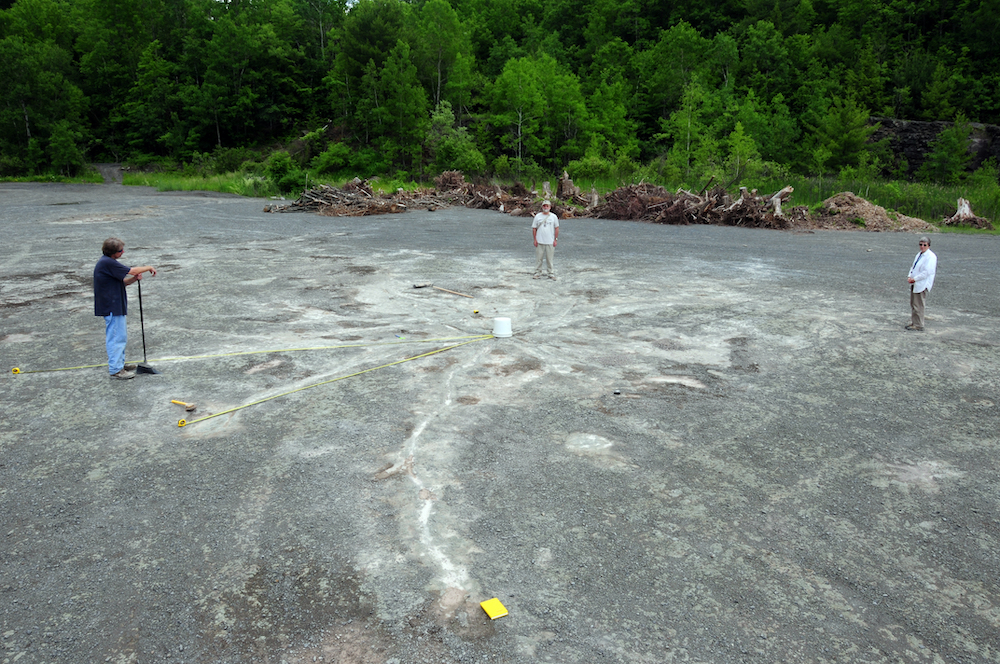Modern trees emerged earlier than previously believed, new research reveals
Modern trees emerged earlier than previously believed, new research reveals

A research team led by faculty at Binghamton University has uncovered evidence that the transition toward forests as we know them today began earlier than typically believed.
While sifting through fossil soils in the Catskill region near Cairo, N.Y., researchers uncovered the extensive root system of 385-million-year old trees that existed during the Devonian Period. While seed plants didn’t appear until some 10 million years later, these preserved root systems show evidence of the presence of trees with leaves and wood — both of which are common in modern seed plants. The finding, published Dec. 19 in Current Biology, is the first piece of evidence that the transition toward modern forests began earlier than previously believed.
“The Devonian Period represents a time in which the first forest appeared on planet Earth,” said lead author William Stein, emeritus professor of biological sciences at Binghamton University. “The effects were of first order magnitude in terms of changes in ecosystems, what happens on the Earth’s surface and oceans, CO2 concentration in the atmosphere and global climate. So many dramatic changes occurred at that time as a result of those original forests that, basically, the world has never been the same since.”
Stein and his team of researchers have been working in the Catskill region in New York, where in 2012 they described “footprint evidence” of the fossil forest at Gilboa, for many years termed the Earth’s oldest forest. The discovery at Cairo, about a 40-minute drive from the original site, now reveals an even older forest with dramatically different composition.
The Cairo site presents three unique root systems, leading Stein and his team to hypothesize that much like today, the forests of the Devonian Period were heterogeneous with different trees occupying different places depending on local conditions.
First, Stein and his team identified a rooting system that they believe belonged to a palm tree-like tree called Eospermatopteris. This plant, first identified at the Gilboa site, had relatively rudimentary roots. Like a weed, Eospermatopteris likely occupied many environments, explaining its presence at both sites. But its roots had relatively limited range and probably lived only a year or two before dying and being replaced by other roots that would occupy the same space.
The researchers also found evidence of a tree called Archaeopteris, which shares a number of characteristics with modern seed plants. Although this tree behaved more like a fern during reproduction, by releasing spores into the air instead of forming seeds, it had early hints at what would one day become seed plants: Archaeopteris is the first known plant to form leaves, and was a large woody plant formed from secondary tissues. At Cairo, this tree was now found to also have a strikingly modern underground system allowing for continuous expansion of roots accommodating continuous growth of a long-lived larger type of tree, and potentially dominating the local forest ecosystem.
“Archaeopteris seems to reveal the beginning of the future of what forests will ultimately become,” said Stein. “Based on what we know from the body fossil evidence of Archaeopteris prior to this, and now from the rooting evidence that we’ve added at Cairo, these plants are very modern compared to other Devonian plants. Although still dramatically different than modern trees, Archaeopteris nevertheless seems to point the way toward the future of forests.”
Stein and his team were also surprised to find a third root system in the fossilized soil at Cairo, belonging to a tree thought to only exist during the Carboniferous Period and beyond: “scale trees” belonging to the class Lycopsida.
“What we have at Cairo is a rooting structure that appears identical to great trees of the Carboniferous coal swamps with fascinating elongated roots. But no one has yet found body fossil evidence of this group this early in the Devonian.” Stein said. “Our findings are perhaps suggestive that these plants were already in the forest, but perhaps in a different environment and earlier than generally believed. Yet we only have a footprint, and we await additional fossil evidence for confirmation.”
Moving forward, Stein and his team hope to continue investigating the Catskill region and compare their findings with fossil forests around the world.
“It seems to me, worldwide, many of these kinds of environments are preserved in fossil soils. And I’d like to know what happened historically, not just in the Catskills, but everywhere,” said Stein. “Understanding evolutionary and ecological history — that’s what I find most satisfying.”
This work was supported by the Natural Environment Research Council of the UK.

